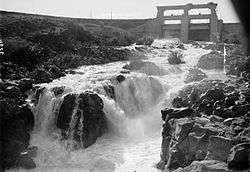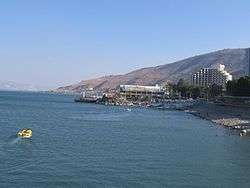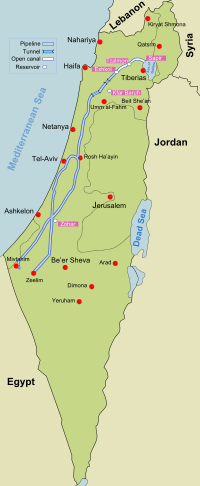War over Water (Jordan river)
The "War over Water", also the Battle over Water, refers to a series of confrontations between Israel and its Arab neighbors from November 1964 to May 1967 over control of water sources in the Jordan River drainage basin.
| The War over Water | |||||||
|---|---|---|---|---|---|---|---|
| Part of the Arab-Israeli conflict | |||||||
| |||||||
| Belligerents | |||||||
|
|
| ||||||
| Commanders and leaders | |||||||
| Yitzhak Rabin | |||||||
History
Early tensions: 1949–64


The 1949 Armistice Agreements which followed the 1948 Arab–Israeli War, created three demilitarized zones on the Israel-Syria border. The southernmost, and also the largest, stretched from the south-eastern part of the Sea of Galilee eastwards to the Yarmuk River where the borders of Israel, Jordan and Syria converge.[1] The issue of water sharing from the Jordan–Yarmuk system turned out to be a major problem between Israel, Syria and Jordan.[2]
Small scale water-related skirmishes had occurred following the 1949 agreements. In July 1953, Israel began construction of an intake for its National Water Carrier at the Daughters of Jacob Jordan Bridge in the demilitarized zone north of the Sea of Galilee. Syrian artillery units opened fire on the construction site. The United Nations security council majority (excepting the USSR) voted for the resumption of work by Israel. The Israelis then moved the intake to an economically inferior site at the Sea of Galilee.[3]
In 1955 the Jordan Valley Unified Water Plan (Johnston Plan) was accepted by the technical committees of both Israel and the Arab League, but the Arab League Council decided not to ratify the plan on 11 October 1955. According to most observers, including Johnston himself, the Arab non-adoption of the plan was not total rejection. While they failed to approve it politically, they nevertheless seemed determined to adhere to the technical details of the agreement. Moreover, it continued to be taken seriously by Arab leaders.[4] Though the Unified Plan failed to be ratified, both Jordan and Israel undertook to operate within their allocation limits.
Main phase: 1964–67
Israel completed its National Water Carrier project, which siphoned water from the Sea of Galilee in 1964. The initial diversion capacity of the National Water Carrier, without supplementary booster pumps, was 320 million m3, well within the limits of the Johnston Plan.

Nevertheless, the Arab states were not prepared to coexist with a project which seemed likely to make a major contribution to Israel's economic growth. In January 1964 an Arab League summit meeting convened in Cairo and decided:
The establishment of Israel is the basic threat that the Arab nation in its entirety has agreed to forestall. And since the existence of Israel is a danger that threatens the Arab nation, the diversion of the Jordan waters by it multiplies the dangers to Arab existence. Accordingly, the Arab states have to prepare the plans necessary for dealing with the political, economic and social aspects, so that if necessary results are not achieved, collective Arab military preparations, when they are not completed, will constitute the ultimate practical means for the final liquidation of Israel.[5]
The Arab states decided to deprive Israel of 35% of the National Water Carrier capacity, by a diversion of the Jordan River headwaters (both the Hasbani and the Banias) to the Yarmouk River. The scheme was only marginally feasible, as it was technically difficult and expensive.
A major escalation took place in 1964 when Israel declared it would regard the Diversion Project as an infringement on its sovereign rights.[6] [7]
In 1965, there were three notable border clashes, starting with Syrian shootings of Israeli farmers and army patrols, followed by Israeli tanks and artillery destroying the Arab heavy earth moving machines that were used for the diversion plan.[8][9] The Arab countries eventually abandoned their project. Control of water resources and Israeli military attacks against the diversion effort are considered among the factors which led to the Six-Day War in June 1967.
The war is referenced in the famous US antiwar 1965 song "Eve of Destruction" by Barry McGuire with the line "And even the Jordan River has bodies floatin'". [10]
Notes
- Lowi, Miriam R. (1995). Water and power: the politics of a scarce resource in the Jordan River basin. Cambridge University Press. ISBN 978-0-521-55836-5.
- Seliktar, Ofira (June 2005). "Turning Water into Fire: the Jordan River as the Hidden Factor in The Six Day War". The Middle East Review of International Affairs. 9 (2).
- Kobori, Iwao; Glantz, M. H.; Aaron T. Wolf (July 1998). Central Eurasian Water Crisis; Caspian, Aral, and Dead Seas. United Nations University Press. pp. 129, 131. ISBN 978-92-808-0925-1. Retrieved 15 July 2013.
see also http://archive.unu.edu/unupress/unupbooks/uu18ce/uu18ce0a.htm#10.%20principles%20for%20confidence%20building%20measures%20in%20the%20jordan%20river%20watershed . In July 1953, Israel began construction on the intake of its National Water Carrier at the Daughters of Jacob Bridge (Gesher B'not Ya'akov) north of the Sea of Galilee and in the demilitarized zone. Syria deployed its armed forces along the border and artillery units opened fire on the construction and engineering sites (Cooley, 1984, pp. 3 and 10). Syria also protested to the United Nations and, although a 1954 resolution for the resumption of work by Israel carried a majority, the USSR vetoed the resolution. The Israelis then moved the intake to its current site at Eshed Kinrot on the north-western shore of the Sea of Galilee (Garbell, 1965, p. 30).
- Moshe Gat (2003). Britain and the Conflict in the Middle East, 1964-1967: The Coming of the Six-Day War. Greenwood Publishing Group. p. 101. ISBN 978-0-275-97514-2. Retrieved 7 September 2013.
[on 1965]Nasser too, assured the American under Secretary of state, Philip Talbot, that the Arabs would not exceed the water quotas prescribed by the Johnston plan
- Avi Shlaim (2000). The Iron Wall: Israel and the Arab World. Penguin Books. pp. 229, 230. ISBN 978-0-14-028870-4.
In January 1964 an Arab League summit meeting convened in Cairo. The main item on the agenda was the threat posed by Israel's diversion of water. The preamble to the final statement stated: "The establishment of Israel is the basic threat that the Arab nation in its entirety has agreed to forestall. And Since the existence of Israel is a danger that threatens the Arab nation, the diversion of the Jordan waters by it multiplies the dangers to Arab existence. Accordingly, the Arab states have to prepare the plans necessary for dealing with the political, economic and social aspects, so that if necessary results are not achieved, collective Arab military preparations, when they are not completed, will constitute the ultimate practical means for the final liquidation of Israel
- Greg Shapland (1997). Rivers of Discord: International Water Disputes in the Middle East. C. Hurst & Co. Publishers. pp. 13–17. ISBN 978-1-85065-214-4. Retrieved 15 July 2013.
- Masahiro Murakami (1995). Managing Water for Peace in the Middle East; Alternative Strategies. United Nations University Press. pp. 287–297. ISBN 978-92-808-0858-2. Retrieved 15 July 2013.
The book appears in: http://archive.unu.edu/unupress/unupbooks/80858e/80858E0m.htm . The initial diversion capacity of the National Water Carrier without supplementary booster pumps was 320 million m3, well within the limits of the Johnston Plan. Shortly before completion of the Israeli Water Carrier in 1964, an Arab summit conference decided to try to thwart it. Forgoing direct military attack, the Arab states chose to divert the Jordan headwaters......the Arab states chose to divert the Jordan headwaters.......diversion of both the Hasbani and the Banias to the Yarmouk.....According to neutral assessments, the scheme was only marginally feasible; it was technically difficult and expensive......Political considerations cited by the Arabs in rejecting the 1955 Johnston Plan were revived to justify the diversion scheme. Particular emphasis was placed on the Carrier's capability to enhance Israel's capacity to absorb immigrants to the detriment of Palestinian refugees. In response, Israel stressed that the National Water Carrier was within the limits of the Johnston Plan......the Arabs started work on the Headwater Diversion project in 1965. Israel declared that it would regard such diversion as an infringement of its sovereign rights. According to estimates, completion of the project would have deprived Israel of 35% of its contemplated withdrawal from the upper Jordan, constituting one-ninth of Israel's annual water budget.......In a series of military strikes, Israel hit the diversion works. The attacks culminated in April 1967 in air strikes deep inside Syria. The increase in water-related Arab-Israeli hostility was a major factor leading to the June 1967 war.
- Benny Morris (25 May 2011). Righteous Victims: A History of the Zionist-Arab Conflict, 1881-1998. Knopf Doubleday Publishing Group. p. 304. ISBN 978-0-307-78805-4. Retrieved 15 July 2013.
- Kobori, Iwao; Glantz, M. H. (July 1998). Central Eurasian Water Crisis; Caspian, Aral, and Dead Seas. United Nations University Press. pp. 129, 131. ISBN 978-92-808-0925-1. Retrieved 15 July 2013.
- http://www.metrolyrics.com/eve-of-destruction-lyrics-barry-mcguire.html
Further reading
- Ameri, Hussein A. (Dec 2002). "Water War in the Middle East: a Looming Threat". The Geographical Journal. 168 (4): 313–323. doi:10.1111/j.0016-7398.2002.00058.x.
- Cooley, John, K. (Spring 1984). "The War over Water". Foreign Policy. 54: 3–26. doi:10.2307/1148352.
- Gat, Moshe (Oct 2004). "The Use of Airpower and its Effects on the Outbreak of the Six Day War". The Journal of Military History. 68 (4): 1187–1215. doi:10.1353/jmh.2004.0194.
- Gleick, Peter, H. (Summer 1993). "Water and Conflict: Fresh Water Resources and International Security". International Security. The MIT Press. 18 (1): 79–112. doi:10.2307/2539033. JSTOR 2539033.
- Haddadin, Munther J. (Dec 2002). "Water in the Middle East Peace Process". The Geographical Journal. 168 (4): 324–340. doi:10.1111/j.0016-7398.2002.00059.x.
- Rook, Robert E. (Winter 2000). "An American in Palestine: Elwood Mead and Zionist Water Resource Planning, 1923-1936". Arab Studies Quarterly. 22 (1): 71–90.